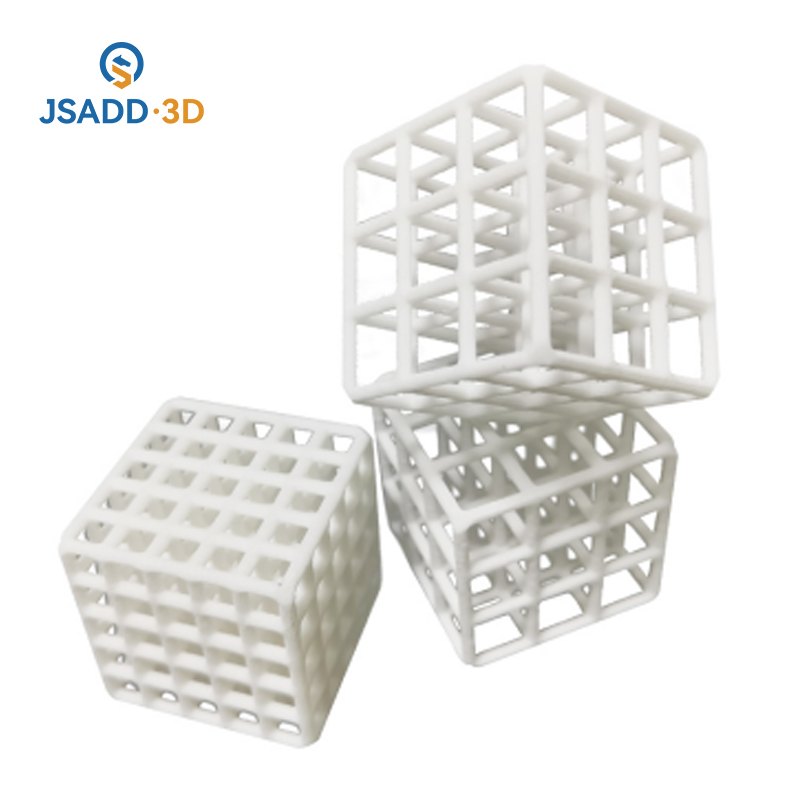To quickly understand the SLS 3D printing service technology , you can grab two key words, powder and sintering, so in the industry SLS is called powder sintering, but also the characteristics of SLS. SLS printing technology uses laying powder to lay a layer of powder material flat on the upper surface of the formed part, and heated to a temperature just below the sintering point of the powder, the control system controls the laser beam according to the cross-sectional profile of the layer The laser beam is controlled by the control system to follow the cross-sectional contour of the layer and scanned over the powder layer to bring the temperature of the powder to the melting point for sintering and bonding with the formed part below. After the completion of one layer, the table drops one layer in thickness and the spreading roller spreads a layer of uniform and dense powder on top to sinter a new layer of cross-section until the whole model is completed.
SLS 3D printing service is now more and more attention by large and medium-sized enterprises, then, how to correctly view SLS 3D printing service technology?
SLS 3D printing service technology can use a large number of materials, including polymer, metal, ceramic, gypsum, nylon and other powders. However, due to the refinement of the market, metal materials are now called SLM. At the same time, 90% of the materials used in SLS in the market should be nylon. So we usually default to SLS is printed nylon material; Now the accuracy is normal and can achieve a tolerance of plus or minus 0.2mm.
There are also many advantages of SLS printing service technology:
1. A wide range of printing materials; The high precision of molding products, the wide range of materials and the short production cycle characteristics, so that its production and processing in the industrial field is favored.
2. Machining complex geometric figures; 3D printing technology breaks through tradition and realizes integrated design and manufacturing. Complex geometries can be built more easily at no additional cost.
3. Without support, it does not need support structure. The suspended layer in the lamination process can be directly supported by unsintered powder, which is one of the biggest advantages of SLS, and the material utilization rate is high. Since there is no need for support and no need to add a base, it has the highest material utilization among several common 3D printing service technologies
, and the price is relatively cheap, but it is more expensive than SLA.
4. Very suitable for functional parts and handboard prototypes; 3D printing services can improve the progress of projects by producing functional end-use parts on demand.
5. Short production cycle, fast and cheap; Compared with the traditional mold processing method, 3D printing technology can be directly produced without mold opening, saving the time of mold opening, and the production and manufacturing efficiency is significantly improved.
Of course, SLS 3D printing service technology more or less also has some limitations and disadvantages:
First, because the raw material is powdery, prototype manufacturing is by the material powder layer after heating melting to achieve layer by layer bonding, therefore, the prototype surface is strictly speaking powder granular, so the surface quality is not high. If the customer has high requirements on the surface quality, the customer can choose SLA or SLS surface spraying treatment.
Second, the sintering process has odor. In SLS process, the powder layer needs to be heated by laser to reach the melting state, and the polymer materials or powder particles will volatilize odor gas during laser sintering.
Third, long processing time is an obvious drawback of SLS. If SLS and SLA are printed for the same part, the delivery time of SLS will be obviously longer. This does not mean that the equipment manufacturer is not helpful, but it is actually determined by the forming principle of SLS. SLS is formed by sintering. Before processing, there should be 2 hours of preheating time. After the part model is printed, it takes 5 to 10 hours to cool down before it can be removed from the powder VAT. How many hours will it take, depending on how many models the machine is printing at the same time, usually 5 to 10 hours, so it will be a little longer.
Fourth, because of the use of high-power laser, in addition to its own equipment cost, but also need a lot of auxiliary protection process, the overall technical difficulty, manufacturing and maintenance costs are very high, ordinary users can not bear.
The SLS printing service technology of JSADD 3D is also quite mature, and there are corresponding SLS printing service cases in overseas countries.
Contributor: Alisa | Lili Lu | Seazon







